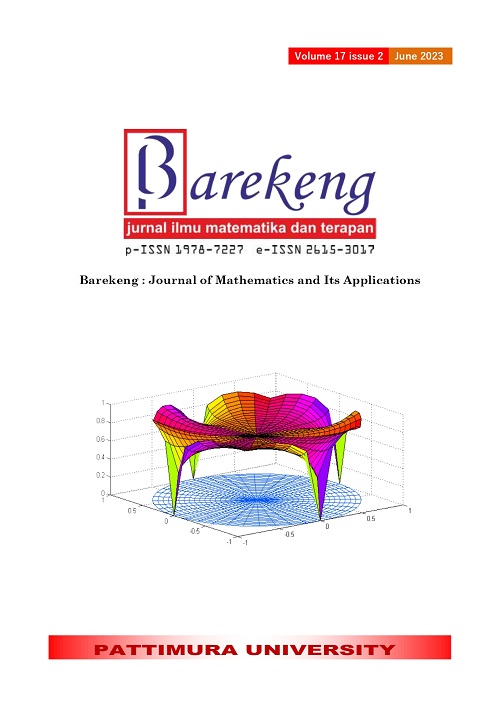FINANCIAL INCLUSION, ECONOMIC GROWTH AND POVERTY IN INDONESIA WITH PANEL SIMULTANEOUS MODELS APPROACH
Abstract
Financial inclusion is a condition that people have equal access to and use financial services. However, in 2021, Indonesia will have the fourth-highest proportion of unbanked citizens worldwide. Economic growth may have an indirect or direct impact on poverty depending on financial inclusion. Several variables that encourage financial inclusion have been described by many studies. This study aims to analyze simultaneous equation models using panel data of financial inclusion, then identify its causality relationship with economic growth and poverty of 33 provinces in Indonesia from 2011-2021. As result, only the variable mean years of school has an effect on increasing of financial inclusion index. The three variables of economic development, namely financial inclusion, economic growth, and poverty have a one-way causality relationship. That is means there has been no visible development synergy in terms of financial inclusion, economic growth, and poverty. It could be an example given to the government in evaluating Indonesia's regional development gap.
Downloads
References
Kemenkeu, “Badan Kebijakan Fiskal - Detail Kajian,” Kementrian Keuangan Republik Indonesia. p. 1, 2021. [Online]. Available: https://fiskal.kemenkeu.go.id/kajian/2013/10/16/103504807419441-free-trade-agreement-fta-dan-economic-partnership-agreement-epa-dan-pengaruhnya-terhadap-arus-perdagangan-dan-investasi-dengan-negara-mitra%0Ahttps://fiskal.kemenkeu.go.id/kajian/2021/08/18/2
N. G. Mankiw, Macroeconomics, Tenth. 2019.
B. B. Ummah, N. Nuryartono, and L. Anggraeni, “Analisis Inklusi Keuangan dan Pemerataan Pendapatan,” J. Ekon. dan Kebijak. Pembang., vol. 4, no. 1, pp. 1–27, 2015.
OJK, “Strategi Nasional Literasi Keuangan Indonesia,” Otoritas Jasa Keuang., p. 378, 2021.
BI, “Digitalisasi Pacu Akses Keuangan Jangkau Perempuan, Kaum Muda dan UMKM,” Bank Indonesia. 2022. [Online]. Available: https://www.bi.go.id/id/publikasi/ruang-media/news-release/Pages/sp_2412322.aspx
M. C. Simatele, Financial inclusion: Basic theories and empirical evidence from African countries. Cape Town: AOSIS, 2021. doi: https://doi.org/10.4102/aosis.2021.BK255.
I. F. Fauzan, M. Firdaus, and S. Sahara, “Regional financial inclusion and poverty: Evidence from Indonesia,” Econ. J. Emerg. Mark., vol. 12, no. 1, pp. 25–38, Apr. 2020, doi: 10.20885/ejem.vol12.iss1.art3.
Y. Shen, W. Hu, and C. J. Hueng, “Digital Financial Inclusion and Economic Growth: A Cross-country Study,” in Procedia Computer Science, 2021, vol. 187, pp. 218–223. doi: 10.1016/j.procs.2021.04.054.
I. M. Sanjaya and Nursechafia, “Inklusi Keuangan dan Pertumbuhan Inklusif: Analisis Antar Provinsi di Indonesia,” Bul. Ekon. Monet. dan Perbank., vol. 18, no. 3, pp. 281–306, 2016.
A. Rifa, A. Lpdp Pk-, P. Magister Sains Ilmu Ekonomi Fakultas Ekonomika dan Bisnis, and U. Gadjah Mada, “Peran Bank Pembiayaan Rakyat Syariah dalam Mengimplementasikan Keuangan Inklusif Melalui Pembiayaan UMKM,” Yogyakarta, 2017.
I. F. Fauzan, “Determinan Inklusi Keuangan di Indonesia dengan Pendekatan Panel Spasial,” Institut Pertanian Bogor, 2019. [Online]. Available: https://repository.ipb.ac.id/handle/123456789/103392
D. N. Gujarati and D. C. Porter, Basic Econometrics, Fifth. New York: McGraw-Hill, 2009.
B. H. Baltagi, Econometric Analysis of Panel Data, Third. England: John Wiley & Sons, Ltd, 2005. [Online]. Available: https://www.ptonline.com/articles/how-to-get-better-mfi-results
N. K. Isnaeni and L. Yuliana, “Faktor-faktor yang mempengaruhi belanja pemerintah fungsi kesehatan di indonesia,” vol. 5, pp. 15–21, 2018.
W. H. Greene, Econometric Analysis, Seventh. New York: Pearson Education, 2001.
H. T. Patrick, “Financial Development and Economic Growth in Underdeveloped Countries: Reply,” 1972. doi: 10.1086/450553.
A. A. N. J. Kusuma and I. G. B. Indrajaya, “Analisis pengaruh inklusi keuangan terhadap tingkat kemiskinan dan ketimpangan pendapatan masyarakat di kabupaten/kota provinsi bali,” E-Jurnal EP Unud, vol. 9, no. 5, pp. 993–1022, 2018, [Online]. Available: http://download.garuda.kemdikbud.go.id/article.php?article=1693127&val=981&title=ANALISIS PENGARUH INKLUSI KEUANGAN TERHADAP TINGKAT KEMISKINAN DAN KETIMPANGAN PENDAPATAN MASYARAKAT DI KABUPATENKOTA PROVINSI BALI
A. Dhrifi, “Financial Development and the ‘Growth-Inequality-Poverty’ Triangle: A Comparative Study between Developed and Developing Countries,” Int. J. Econ. Financ. Manag., vol. 2, no. 7, pp. 472–481, 2013, [Online]. Available: http://www.ejournalofbusiness.org
C.-Y. Park and R. V Mercado, “Financial Inclusion, Poverty, and Income Inequality in Developing Asia,” 2015. [Online]. Available: www.adb.org
Copyright (c) 2023 Munifah Zuhra Almasah, Timbang Sirait

This work is licensed under a Creative Commons Attribution-ShareAlike 4.0 International License.
Authors who publish with this Journal agree to the following terms:
- Author retain copyright and grant the journal right of first publication with the work simultaneously licensed under a creative commons attribution license that allow others to share the work within an acknowledgement of the work’s authorship and initial publication of this journal.
- Authors are able to enter into separate, additional contractual arrangement for the non-exclusive distribution of the journal’s published version of the work (e.g. acknowledgement of its initial publication in this journal).
- Authors are permitted and encouraged to post their work online (e.g. in institutional repositories or on their websites) prior to and during the submission process, as it can lead to productive exchanges, as well as earlier and greater citation of published works.






1.gif)



